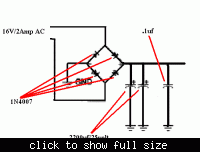cutedrummerboy
Newbie level 6
i have a 16v 2 amp transformer, i make a bridge with 1N4007 and after the bridge two 2200uf/25volt and a .1uf disc type capacitor is paralleled. now when i switched on, two of my diodes is burned... can anyone help me to rectify this problem. i am a newbie to electronics. thanks in advance. here is my schematic:

